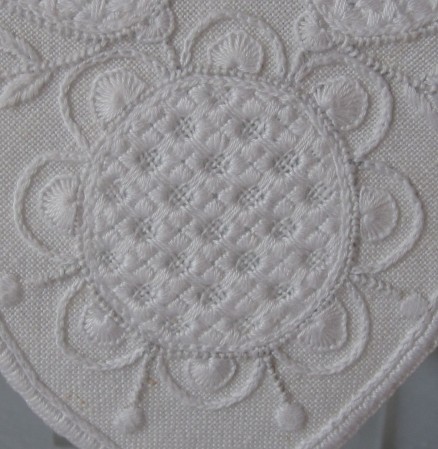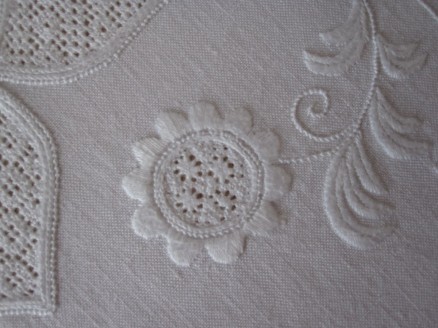The simple motifs are often enhanced with embellishment. So, a circle is seldom seen unadorned, and hearts are usually decorated.
The customary form of decorating simple Schwalm motifs is to outline the shapes with scallops; they look nice and they are easy to embroider.

The scallops are placed close together.

Circle outlined with uniform and evenly distributed half-eyelet scallops. The thread weight is correct, and the stitches have been worked with the appropriate density.

Heart outlined, except for the bottom and top center, with uniform and evenly distributed half-eyelet scallops. The thread weight is correct, and the stitches have been worked with the appropriate density.

Heart outlined with half-eyelet scallops. The thread weight is correct with appropriately dense stitches. Some of the scallops should be closer together and the bottom point should have only one scallop.

Heart outlined with scallops. The thread weight is correct and the density of the stitches is good. However, the treatment of the scallops at the heart’s lower point is not attractive.

Tulip outlined with scallops utilizing the correct thread weight. The density of the stitches is not consistent. In this example, one can see that the embroiderer had difficulty distributing the scallops evenly – especially along the curved line at the top of the tulip.
especially along the curved line at the top of the tulip.

Tulip embellishment with half-eyelet scallops. The thread weight and the density of the stitches are both correct.

Tulip embellishment with half-eyelet scallops of differing sizes. The thread weight and the density of the stitches are both correct.

Tulip embellishment with uniform half-eyelet scallops. The thread weight and the density of the stitches are both correct.

Tulip embellishment with uniform half-eyelet scallops. The thread weight and the density of the stitches are both correct. However, it would be more aesthetically pleasing to put a single scallop at the center point, rather than having two scallops meet there.

Heart outlined, except for the bottom and top center, with uniform and evenly distributed half-eyelet scallops. The thread weight is correct, but the density is not. The scallops should have more stitches.
Scallops with a radius of 1 cm are perfect. Of course, the scallops must be in proportion to the motif – smaller motifs need smaller scallops. However, a scallop’s radius should not be smaller than ½ cm.

Circle outlined with uniform and evenly distributed half-eyelet scallops. However, they are too large. The thread weight and the density of the stitches are both correct. A larger scallop needs more stitches to become sufficiently covered; it is difficult to get an orderly appearance with so many stitches radiating from the same point.

Circle outlined with uniform and evenly distributed half-eyelet scallops. The individual scallops are divided and worked with the appropriate thread weight, and the stitches have been worked with the appropriate density. The additional embroidered parts also utilize the correct thread weight.

Circle outlined with uniform and evenly distributed scallops. The scallops have been embroidered using precisely placed Satin stitches.

Circle outlined with uniform and evenly distributed scallops. However, the thread is too thin and the stitch density is not correct.




This is beautiful I will try and these at some point and hope they are as good